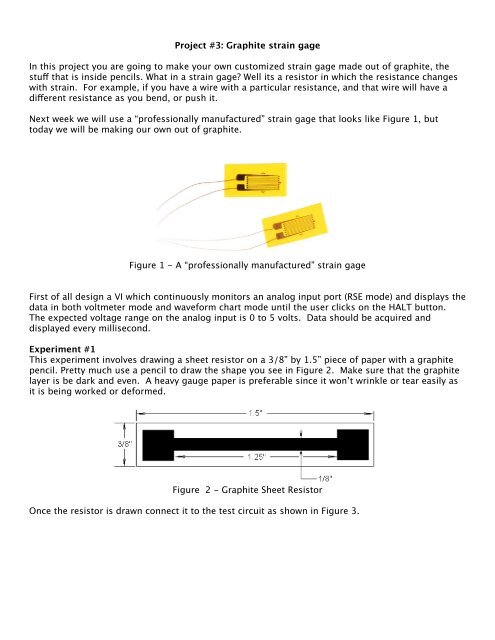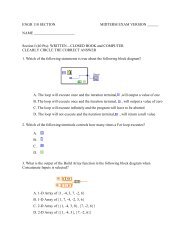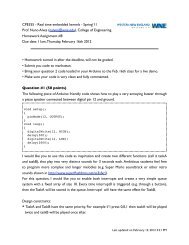Project #3: Graphite strain gage In this project you are ... - Nuno Alves
Project #3: Graphite strain gage In this project you are ... - Nuno Alves
Project #3: Graphite strain gage In this project you are ... - Nuno Alves
You also want an ePaper? Increase the reach of your titles
YUMPU automatically turns print PDFs into web optimized ePapers that Google loves.
<strong>Project</strong> <strong>#3</strong>: <strong>Graphite</strong> <strong>strain</strong> <strong>gage</strong><strong>In</strong> <strong>this</strong> <strong>project</strong> <strong>you</strong> <strong>are</strong> going to make <strong>you</strong>r own customized <strong>strain</strong> <strong>gage</strong> made out of graphite, thestuff that is inside pencils. What in a <strong>strain</strong> <strong>gage</strong>? Well its a resistor in which the resistance changeswith <strong>strain</strong>. For example, if <strong>you</strong> have a wire with a particular resistance, and that wire will have adifferent resistance as <strong>you</strong> bend, or push it.Next week we will use a “professionally manufactured” <strong>strain</strong> <strong>gage</strong> that looks like Figure 1, buttoday we will be making our own out of graphite.Figure 1 - A “professionally manufactured” <strong>strain</strong> <strong>gage</strong>First of all design a VI which continuously monitors an analog input port (RSE mode) and displays thedata in both voltmeter mode and waveform chart mode until the user clicks on the HALT button.The expected voltage range on the analog input is 0 to 5 volts. Data should be acquired anddisplayed every millisecond.Experiment #1This experiment involves drawing a sheet resistor on a 3/8” by 1.5” piece of paper with a graphitepencil. Pretty much use a pencil to draw the shape <strong>you</strong> see in Figure 2. Make sure that the graphitelayer is be dark and even. A heavy gauge paper is preferable since it won’t wrinkle or tear easily asit is being worked or deformed.Figure 2 - <strong>Graphite</strong> Sheet ResistorOnce the resistor is drawn connect it to the test circuit as shown in Figure 3.
Fig. 3 - Test ConfigurationStart the VI and ‘trim’ the resistor (by making the resistor body thicker or thinner by adding orerasing graphite) so that <strong>you</strong> end up with an output value of 2.5 volts (plus or minus 10%) displayedon the voltmeter and waveform chart. This process is similar to what manufacturers do when theylaser trim resistor values on a microchip.Once <strong>you</strong> have trimmed the resistor value flex (but don’t wrinkle or fold) the resistor’s ‘substrate’ sothat the paper is either concave up or down.• Notice how the voltage on <strong>you</strong>r display changes value. You <strong>are</strong> changing the shape of the resistorand thereby changing the value of the resistor. How much voltage change do <strong>you</strong> see?• Touch one of the alligator clips while <strong>you</strong> <strong>are</strong> visualizing the analog input. What do <strong>you</strong> observe on<strong>you</strong> waveform chart?• Go into one of the electrical engineering (eg. S219) labs and ask someone in there to show <strong>you</strong>how to measure the resistance of <strong>you</strong>r graphite resistor. What is it? Can <strong>you</strong> devise a formula thatwill give <strong>you</strong> that resistor value relating the analog input, the 5V and the resistor value (the nongraphiteresistor that is connected to ground)? You may measure the non-graphite resistor or figureout its value from the resistor table chart I’ve showed <strong>you</strong> last class.Experiment #2Draw two other resistors. One twice as wide as the resistor on Figure 2, and the other resistor twiceas long.• What happens to the voltage when <strong>you</strong> use these new graphite resistors? Write a couple of linesdescribing <strong>you</strong>r results as well as <strong>you</strong>r explanation about them. Think what is happening at theelectron level.• Do these obtained experimental results match <strong>you</strong>r expected outcome?
















